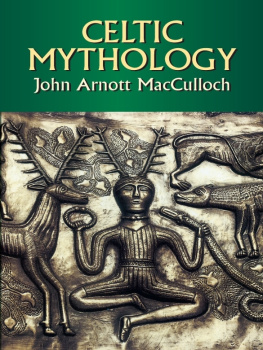CHAPTER I
FORESTS OF ELD
Archan Forests;Primeval and Tropical Forests;Cosmogonic and Traditional Forests.
THE earliest vegetation of our globe must have been of the simplest possible type, as during the Archan Age the earth still retained much of its original internal heat, and the resulting close, warm and damp climate, with the superabundant quantity of carbonic acid gas in the atmosphere, would be favourable to the growth and development of Fungi, Moulds, Alg, Mosses and similar plants. Judging from the analogy of after ages, when gigantic plants appeared during the Carboniferous Era, and enormous reptiles had their being throughout Jurassic times, probably these now lowly plant forms attained dimensions far exceeding those of our loftiest forest trees of the present day. If one can imagine the forests of that period, there would probably have been seen enormous toadstools with their domed summits extending over many yards; patches of gigantic mosses pushing up their vast spore urns into the murky sky; or mighty masses of cellular moulds ramifying in every direction and producing thickets of globular spore cases borne on long cellular stalks. Absolute silence would reign in the cimmerian gloom; no song of bird would be heard, no chirp of insect, nor rustle of leaf, for none of these yet had being. Even during the tempests which must often have raged through these forests, no crash of falling trees would resound; the soft cellular tissue would sink noiselessly to earth. In the waters which in all likelihood at that time constituted the greater part of the surface of the globe, strange and gigantic forms of alg would rear themselves above the surface, and all the various forms of vegetation would be of one uniform sombre hue. During unnumbered ons, from these simple cellular plants were gradually evolved the mighty piniferous (if they may be so called) forests of the Carbonaceous Age, and, later, the highly organised trees of the forest which are now familiar to us.
Each succeeding geological period had its own peculiar type of vegetation which had all been leading up to that immense development of plant life known as the Carboniferous period, the remains of which form our coal seams. Never before or since had there been such an exuberance of plant life. So luxuriant was the plant growth over the whole globe that to the inhabitants of other planets this world would probably be known as the green star. A strange picture indeed, these forests, with their towering reeds and their gigantic club-mosses, must have presented had there been human eye to see. In addition to the damp steamy atmosphere, an ever-clouded sky hung over these forests, reaching from pole to pole. During the daytime a pallid light would shed a lurid glimmer through the shadowy recesses, bringing into relief here and there the naked trunks of Sigillarias, while, above, the hirsute arms of the Lepidodendrons would wave ghostlike in the gentle breeze, or toss wildly when a hurricane swept through the forest carrying destruction in its path.
As the milleniums passed, other epochs of time held their sway, until at the close of the glacial periods forests as we now know them covered the land, and, apart from their utilitarian purposes, a very wealth of romance lies hidden within their bosky depths. There, the voice of Nature speaks to the weary wayfarer; the rustling and whispering of the leaves; the sad, yet sweet, cooing of pigeons; the melody of songbirds, or the distant cawing of rooks; the hum of innumerable insects: all impart a feeling of rest, and the strife and jealousies of the world seem far removed. Here in the sunny glades of the forest the ground is carpeted with mosses and flowers, while all around the view is bounded by gigantic trunks of trees each clad with many-coloured lichens, and the whole canopied with leafy boughs whence the feathered orchestra of the woods pour forth their divine melody. It is recorded that the monk of Hildesheim, doubting how with God a thousand years could be as yesterday, listened to the melody of a bird in the green wood during three minutes, and found that in these three minutes three hundred years had flown.
To a wanderer in forest solitudes a sense of mystery is often perceived which lures him on and on into the verdant depths of the woodland world. On a brilliant summer day the tremulous throbbing of the air, seemingly full of whisperings and sighings from an unseen host, appears like the pulsation from the mighty heart of the forest, while, all around, sunlight and shadow form a tangled web of enchantment, which is deepened by soft elusive perfumes floating on the damp zephyrs. In fancy he may feel drawn back to the early primitive ages, when the forest deities would have had a very real existence to him, and he would understand the inner meaning of those oracles which were often spoken in the glades of the primeval woods.
Every season of the year imparts its own peculiar beauty to the forests. In early spring a shimmer of tenderest green spreads over them, especially when a forest of Beeches is breaking into leaf, as if the wand of an enchanter had been waved over it. These tints gradually deepen with the advent of summer, when in the hot noontide hours the tired wanderer may repose in the cool shade, lulled to rest by the hum of insects and the music of rustling leaves. When autumn comes, what an inimitable palette of gorgeous colour is spread out before the eye, albeit but the symptom of decay; and when winter holds the land in its icy grasp, even then the forest has a grandeur and a grace all its own, especially when the branches and twigs glitter in the sunshine with hoarfrost, or gracefully bend under a dazzling weight of snow. It has been said that the forest knows all and is able to teach all, and there is a French proverb to the effect that the forest, which always listens, has the secret of every mystery, while a Latin proverb of the Middle Ages says: Aures sunt nemoris, oculi campestribus oris, and similarly the German: Das Feld hat Augen, der Wald hat Ohren.
In Asia vast forests yet exist in many unexplored quarters in much the same condition as they did in primeval ages, and in their depths myth and superstition still hold full sway. According to Pliny (Nat. Hist., Bk. vi. c. 34) there were forests beyond the shores of the Red Sea in which the city of Ptolemais was situated near Lake Monoleus, which city had been built by Philadelphus for the pursuit of the elephant, and that in consequence it had been called Epitheras. When Timour the Tartar subdued the Kingdom of Kashgar, he marched to a distance of about 1,440 miles towards the northeast of Samarcand, crossing the River Irtish, into the depths of these forests, and in them his emirs erected a rude memorial to commemorate their exploits.
Palestine is one of those ancient seats of civilisation which in former times contained numerous forests, but which now, owing to the ravages of war and the improvidence of the people except in a few districts, is a comparatively bare and treeless land. The Old Testament has many references to forests, the best known of which were those of Mount Lebanon, and the venerable Cedars growing thereon are perhaps the most solemnly impressive trees in the world. A full century before the days of King Solomon one Zekar-baal reigned as king in the city of Byblus on the Syrian coast, which city was said to have been founded by the great god El, and to have been the oldest in Phoenicia. An Egyptian merchant named Wen-Ammon traded with the king, and kept a record of his transactions written on papyrus. He records that he stayed for some time with the king at Byblus, and on his leaving they exchanged presents, he receiving a supply of timber which had been felled in the forests of Lebanon. There was also a sacred Cedar Forest at Elam. (See Art. Paradise,













